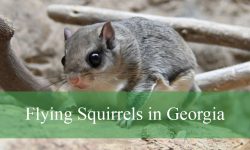Oklahoma’s diverse landscapes provide a rich habitat for an impressive range of snakes. From riverbanks to open plains and forested hills, these environments support both common and rarely seen snake species across the state. Understanding the local serpent population can be valuable for nature enthusiasts, hikers, and homeowners alike.
Exploring the many types of snakes in Oklahoma helps shed light on their behaviors, appearance, and ecological roles. While some are venomous and require caution, the majority are harmless and even beneficial to humans.
This guide covers 51 fascinating types of snakes in Oklahoma, complete with identification tips and photos to help you recognize each one in the wild.
Venomous Snakes in Oklahoma
Eastern Copperhead (Agkistrodon contortrix)

The Eastern Copperhead is a medium-sized venomous snake identified by its copper-colored head and hourglass-shaped crossbands on a light brown to tan background. Adults typically grow between 24 and 36 inches long. Its excellent camouflage helps it remain hidden among fallen leaves and forest debris, aiding both its defense and hunting strategy.
Although venomous, the Eastern Copperhead is generally non-aggressive and will often freeze or rely on its camouflage rather than bite. Its venom is hemotoxic, causing pain and swelling but rarely life-threatening to humans. It feeds on small rodents, frogs, and insects.
In Oklahoma, this species is commonly found in the eastern and central regions, particularly in woodlands, rocky hillsides, and near streams. It tends to be active during warmer months, becoming nocturnal in the heat of summer and occasionally basking in the sun during spring and fall.
Broad-banded Copperhead (Agkistrodon laticinctus)
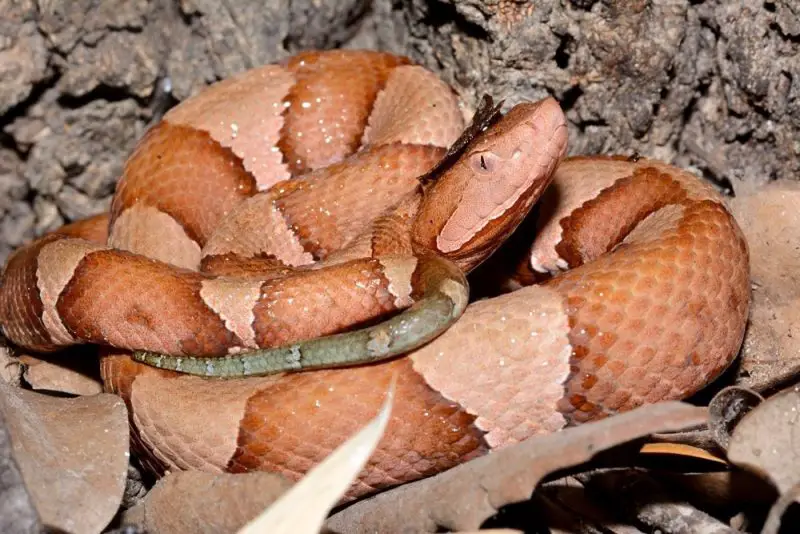
The Broad-banded Copperhead resembles the Eastern Copperhead but has wider, more uniform dark bands over a reddish to tan body. Its patterns are less hourglass-like and more evenly spaced. Adults generally measure between 20 and 36 inches and are stockier than many other pit vipers.
Its venom is mild compared to other pit vipers and is used primarily to subdue prey such as lizards, amphibians, and small mammals. Bites to humans are rarely serious, and this snake tends to avoid confrontation by staying motionless and relying on camouflage.
This species is found in central and southwestern Oklahoma, preferring rocky prairies, brushy woodlands, and open hillsides. It is mostly active at night during warmer seasons but may be seen basking during cooler days in spring and fall.
Western Diamond-backed Rattlesnake (Crotalus atrox)
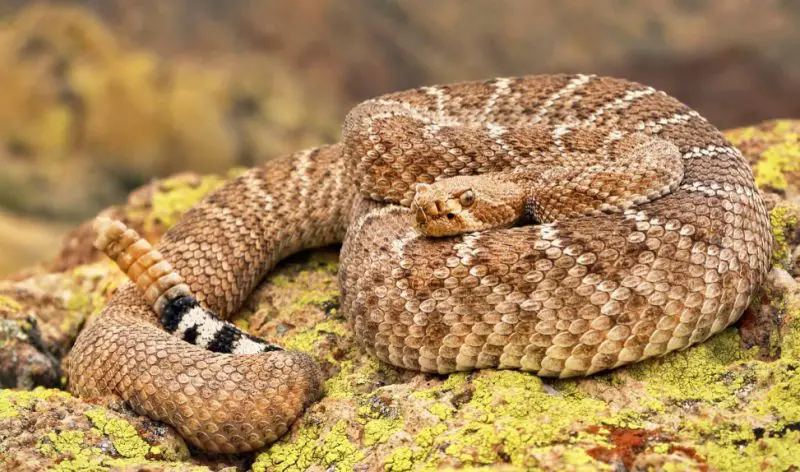
The Western Diamond-backed Rattlesnake is one of Oklahoma’s largest venomous snakes, growing between 3 and 5 feet in length. It features a series of diamond-shaped patterns along its back and a characteristic black-and-white banded tail ending in a prominent rattle. Its body is thick and muscular.
This snake has potent hemotoxic venom and delivers a warning rattle when threatened. Despite its fearsome reputation, it prefers to avoid conflict. It hunts rodents, birds, and reptiles, using its heat-sensing pits to locate warm-blooded prey.
In Oklahoma, it is commonly found in the western and southwestern regions in dry grasslands, rocky outcrops, and desert scrub. It is active during warm weather and may be encountered sunning on rocks or near burrow entrances.
Timber Rattlesnake (Crotalus horridus)
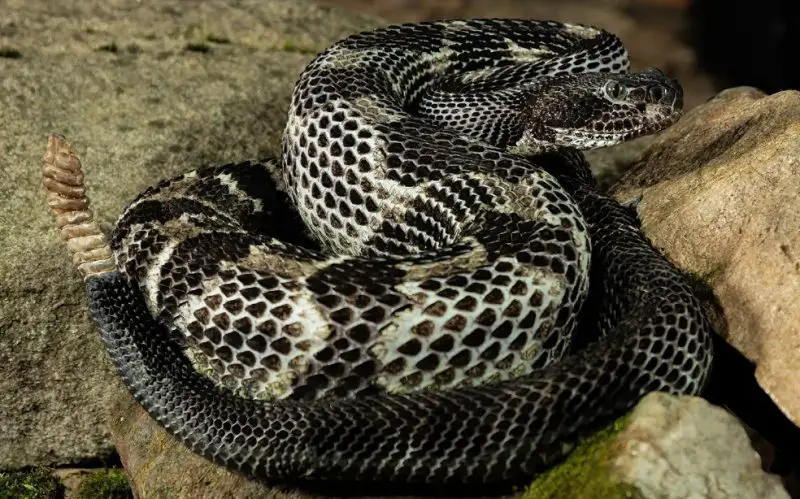
The Timber Rattlesnake is a heavy-bodied snake marked with dark bands on a gray, brown, or yellow background, often with a rust-colored stripe along its spine. It typically reaches lengths between 3 and 5 feet. Its large size and distinct rattle make it one of the more imposing native snakes.
Its venom includes both hemotoxic and neurotoxic elements, making it dangerous though rarely encountered by humans. It is generally docile and avoids confrontation, relying on ambush tactics to capture rodents, birds, and other small animals.
This species is found in the forested regions of eastern Oklahoma, especially in rocky ridges, valleys, and bluffs. It is most active during spring and fall and can often be seen basking on sunny slopes or forest clearings.
Western Massasauga (Sistrurus tergeminus)

The Western Massasauga is a small rattlesnake, usually between 18 and 30 inches long. It has a light gray or tan body with a series of dark blotches running along its back and smaller ones on the sides. Its head is slightly triangular, and its tail ends in a small rattle.
This species produces a mild cytotoxic venom that can cause swelling and discomfort but is rarely dangerous to humans. It is secretive and shy, often hiding in vegetation or beneath rocks. It feeds on small vertebrates and invertebrates like mice, frogs, and insects.
In Oklahoma, it is most common in the central and northern prairies, especially near wetlands, grasslands, and pastures. It is elusive and seldom seen due to its camouflage and reclusive behavior.
Pygmy Rattlesnake (Sistrurus miliarius)

The Pygmy Rattlesnake is the smallest rattlesnake species found in Oklahoma, typically growing only 15 to 24 inches in length. It has a stout body with a gray or tan background and dark blotches along the back and sides, often accompanied by a reddish dorsal stripe. Its tiny rattle can be difficult to hear, making it harder to detect.
Though venomous, its bite is usually not life-threatening due to the small quantity of venom delivered. The venom is cytotoxic and used to subdue small prey like lizards, frogs, and insects. This snake is often still and cryptic, relying on camouflage to avoid predators.
In Oklahoma, Pygmy Rattlesnakes are primarily found in the southeastern part of the state, favoring pine forests, mixed woodlands, and sandy or rocky terrain. They are secretive and often remain hidden under leaf litter, logs, or flat rocks.
Prairie Rattlesnake (Crotalus viridis)

The Prairie Rattlesnake is a medium to large venomous species that can reach lengths of 3 to 5 feet. It is light brown or greenish-tan with dark oval blotches along its back, and it has a more slender body compared to other rattlesnakes. Its triangular head and rattling tail are classic pit viper features.
It has potent hemotoxic venom that can cause significant tissue damage, though fatalities are rare with medical treatment. The Prairie Rattlesnake is alert and defensive and will often rattle loudly and coil before striking if threatened.
In Oklahoma, it is found mostly in the western and northwestern regions, particularly in open grasslands, rocky outcrops, and prairies. It is diurnal in cooler months and becomes more nocturnal during the summer heat.
Northern Cottonmouth (Agkistrodon piscivorus)
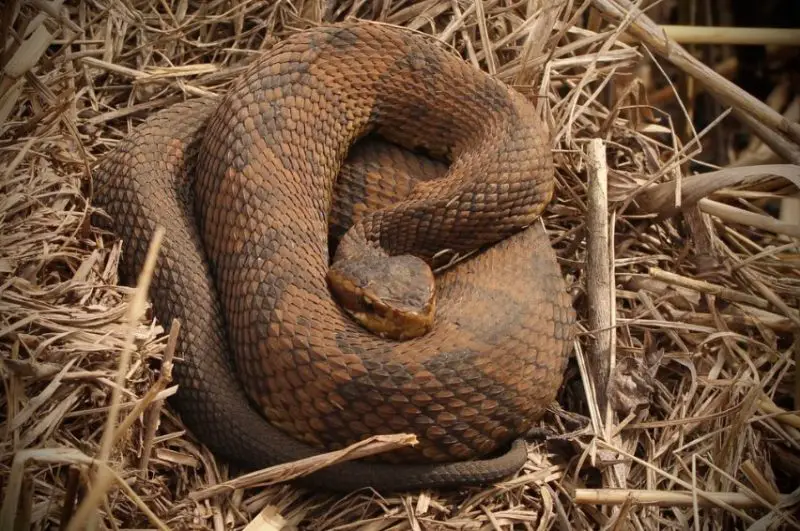
The Northern Cottonmouth, also known as the water moccasin, is a heavy-bodied venomous snake known for its aggressive reputation and white, cotton-like mouth lining displayed when threatened. It usually measures between 30 and 48 inches long and is dark olive or black with faint banding that fades with age.
Its venom is cytotoxic and hemotoxic, and though rarely fatal, its bite can cause severe tissue damage. It is semi-aquatic and hunts fish, amphibians, and small mammals both in and near water. When disturbed, it may stand its ground with an open-mouth display.
In Oklahoma, the Northern Cottonmouth is found primarily in the southeastern corner of the state, especially near swamps, rivers, wetlands, and marshes. It is one of the few venomous snakes in the region commonly encountered near water.
Non-Venomous Snakes in Oklahoma
Western Ratsnake (Pantherophis obsoletus)
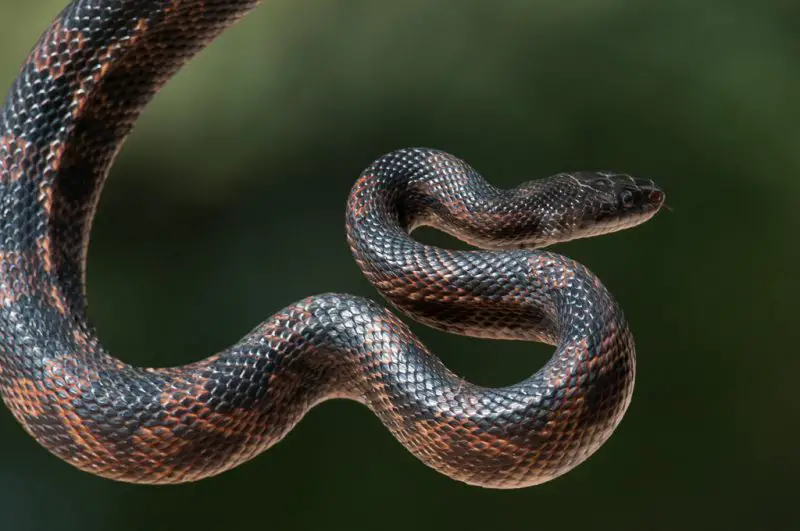
The Western Ratsnake, also called the black ratsnake, is a non-venomous constrictor that typically grows between 3.5 and 6 feet in length. Adults are usually solid black with a white or gray chin and throat, while juveniles display a patterned gray and brown appearance that fades with age. Its body is slender and agile, ideal for climbing trees and navigating tight spaces.
This snake preys on rodents, birds, and eggs, making it beneficial for pest control. It kills by constriction and poses no threat to humans. When threatened, it may vibrate its tail or emit a musky odor but rarely bites. It is generally calm and easy to handle.
In Oklahoma, the Western Ratsnake is widespread, especially in forested areas, farmlands, and rocky hillsides. It is an excellent climber and can often be found in barns, trees, and abandoned buildings in search of prey or shelter.
Plain-bellied Watersnake (Nerodia erythrogaster)
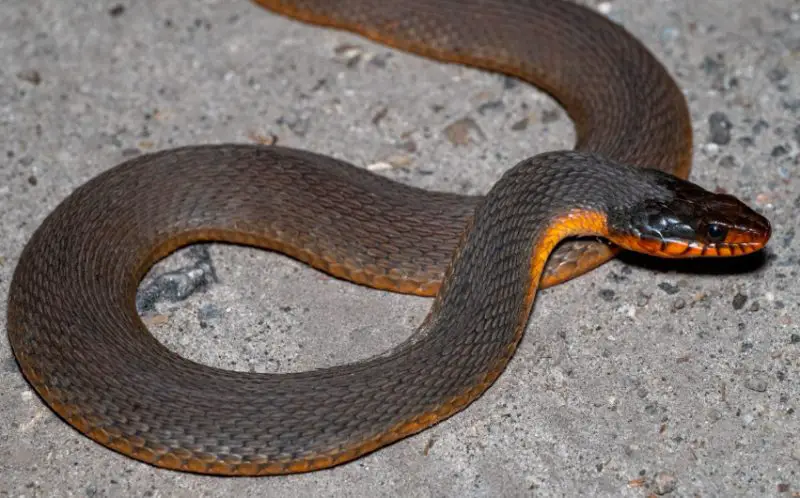
The Plain-bellied Watersnake is a medium to large non-venomous aquatic snake that grows between 24 and 40 inches long. It has a plain yellow, orange, or red underside and a dark olive to brown or gray back. Its appearance may vary slightly depending on the region and age of the snake.
Though non-venomous, it is often mistaken for the venomous cottonmouth due to its similar habitat and defensive behavior. It may flatten its body and release a foul-smelling musk when threatened. It feeds mainly on amphibians and fish and is often seen basking near water bodies.
In Oklahoma, it is found primarily in the eastern and southern parts of the state near lakes, ponds, streams, and marshes. It is most active during the warm months and is frequently observed swimming or resting along the water’s edge.
Dekay’s Brownsnake (Storeria dekayi)
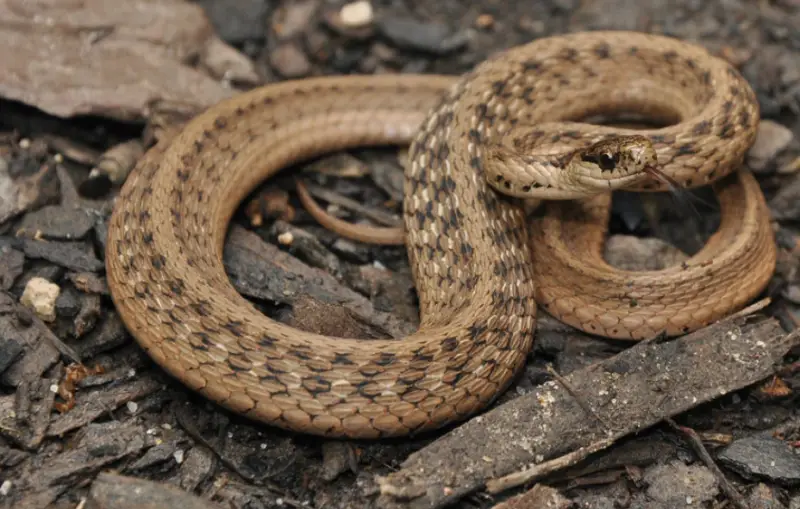
Dekay’s Brownsnake is a small, secretive species that usually reaches only 9 to 13 inches in length. It has a slender body with a light brown to gray coloration and a distinctive dark stripe bordered by lighter lines running down its back. It may also have small black spots along the sides.
This non-venomous snake feeds mostly on earthworms, slugs, and soft-bodied insects. It is harmless to humans and rarely bites, even when handled. It spends much of its time hiding under rocks, logs, and leaf litter, especially in moist environments.
In Oklahoma, Dekay’s Brownsnake is found in a wide range of habitats, including urban areas, gardens, forests, and fields. It is one of the most common small snakes in the state, particularly in the eastern and central regions.
Ring-necked Snake (Diadophis punctatus)

The Ring-necked Snake is a small, slender species that typically grows 10 to 15 inches long. It is easily recognized by its dark bluish-gray to black body and a distinctive yellow, orange, or red ring around its neck. The underside is bright and often marked with small black spots near the tail.
It is non-venomous and harmless to humans, though it may release a musky odor or curl its tail when disturbed. Its diet consists mainly of small amphibians, earthworms, and insects. It is mostly nocturnal and rarely seen during the day.
In Oklahoma, the Ring-necked Snake is found in a variety of moist, shaded environments such as woodlands, hillsides, and rocky outcrops. It is more common in the eastern parts of the state, where cover and humidity are abundant.
Western Ribbon Snake (Thamnophis proximus)

The Western Ribbon Snake is a slender, fast-moving snake that typically ranges from 20 to 30 inches long. It has a distinctive pattern with three light stripes running the length of its black or dark brown body. The belly is pale, and the tail makes up about one-third of its total length.
Non-venomous and harmless to humans, the Western Ribbon Snake is active during the day and is often seen near water. It preys on amphibians, small fish, and insects, capturing them with quick strikes. When disturbed, it will flee swiftly or dive into water.
This species is widespread across Oklahoma, especially in areas with abundant vegetation near streams, ponds, and wetlands. It thrives in both rural and suburban habitats where water is nearby.
Diamondback Watersnake (Nerodia rhombifer)
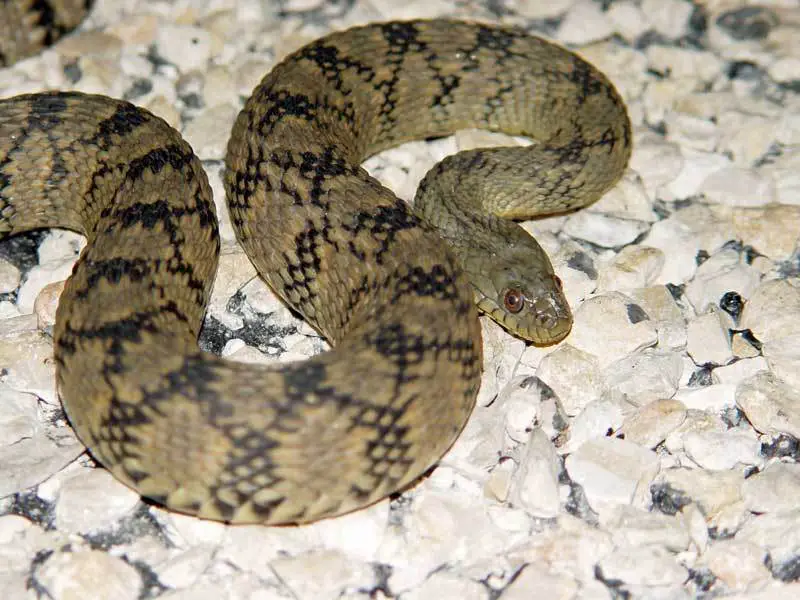
The Diamondback Watersnake is a large, non-venomous aquatic snake that can grow between 30 and 48 inches in length. It has a heavy body with a dark brown to olive coloration and a pattern of diamond-shaped markings that give it its name. The belly is usually yellowish with dark half-moon shapes.
Despite its intimidating appearance and defensive behavior, including hissing and biting when cornered, it is not venomous. It feeds on fish and amphibians, using its sharp teeth to grip slippery prey. It is an excellent swimmer and often seen basking near water.
In Oklahoma, the Diamondback Watersnake is widespread, especially in the eastern and central parts of the state. It inhabits rivers, lakes, ponds, and marshes, where it thrives in both natural and man-made aquatic environments.
Rough Greensnake (Opheodrys aestivus)
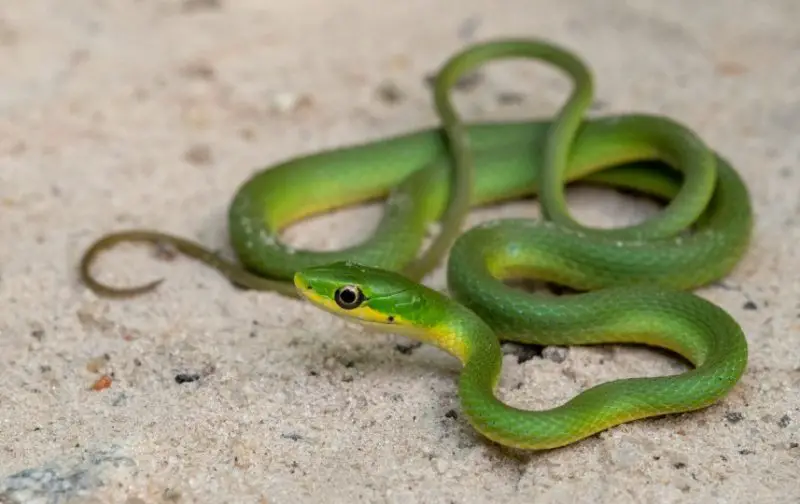
The Rough Greensnake is a slender, bright green non-venomous snake that typically grows between 20 and 32 inches long. Its vibrant coloration helps it blend into foliage, making it difficult to spot in its natural habitat. It has keeled scales that give its skin a rough texture, unlike the smooth scales of similar species.
This harmless snake feeds mainly on insects and spiders, using quick movements to capture its prey in low vegetation. It rarely bites and usually relies on camouflage to avoid predators. Its docile nature makes it a favorite among snake enthusiasts.
In Oklahoma, the Rough Greensnake is most common in the eastern portion of the state. It prefers habitats with dense shrubs or trees near water, such as forest edges, creek banks, and overgrown fields.
North American Racer (Coluber constrictor)

The North American Racer is a long, slender snake that can grow between 36 and 60 inches. Adults are usually solid black or dark gray with a white or light-colored chin, while juveniles have a blotched pattern. Its smooth scales and agile body allow it to move swiftly.
It is non-venomous and preys on insects, small mammals, lizards, and even other snakes. Racers are known for their speed and alertness, often fleeing quickly when approached. They may vibrate their tails and strike if cornered but rarely bite.
In Oklahoma, this species is found across most of the state in open woodlands, prairies, and farmlands. It is diurnal and often seen basking in the sun or darting across paths on warm days.
Speckled Kingsnake (Lampropeltis holbrooki)
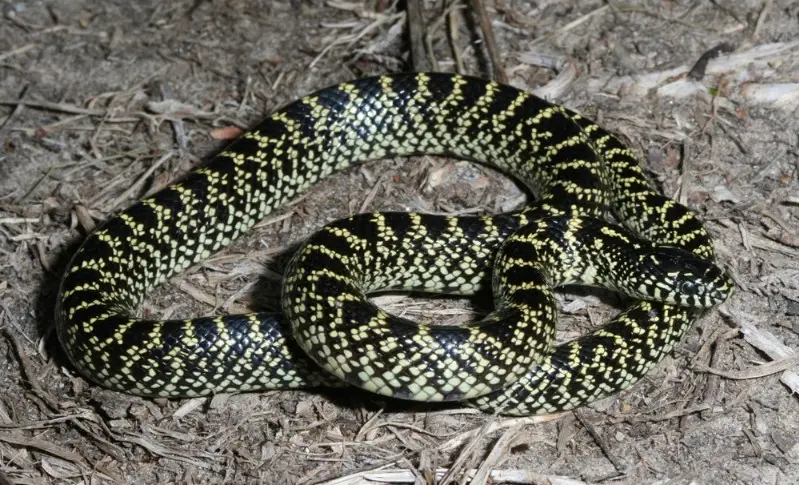
The Speckled Kingsnake is a medium-sized non-venomous snake that ranges from 36 to 48 inches in length. Its black body is covered in small white or yellow spots, giving it a speckled appearance. It has a glossy, smooth-scaled body and a broad head that blends with the neck.
Known for eating other snakes, including venomous ones, it is immune to pit viper venom. It also consumes rodents, birds, and amphibians. It kills prey through constriction and is usually calm, though it may musk or rattle its tail when threatened.
In Oklahoma, the Speckled Kingsnake is widely distributed in grasslands, forests, and wetlands. It is adaptable and often found under logs, boards, or debris in both rural and suburban settings.
Coachwhip (Masticophis flagellum)
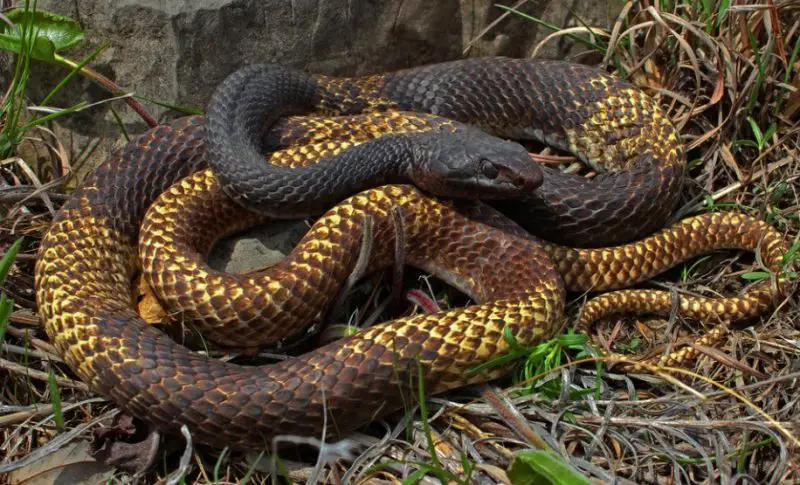
The Coachwhip is a long, slender, fast-moving snake that can grow from 42 to 72 inches. It has a braided-whip appearance, with a color gradient ranging from dark brown or black at the head to tan or pinkish near the tail. Its scales are smooth, and it has large eyes with round pupils.
This non-venomous snake is extremely fast and relies on speed to escape predators. It actively hunts lizards, small mammals, and birds during the day. It may appear aggressive when cornered but rarely bites unless handled.
In Oklahoma, Coachwhips are found mostly in the western and southern parts of the state. They prefer dry, open habitats such as grasslands, scrublands, and rocky hillsides, and are often seen darting across trails or roads.
Common Garter Snake (Thamnophis sirtalis)
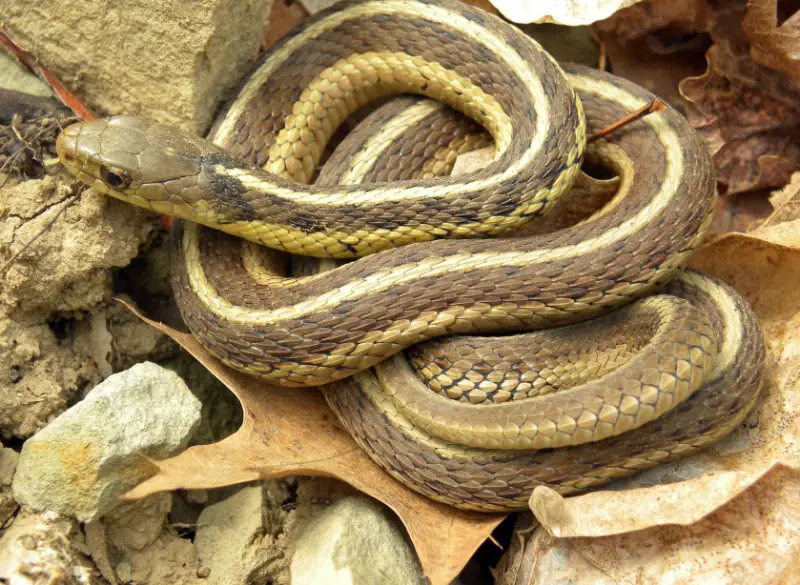
The Common Garter Snake is a widespread, non-venomous snake that typically grows between 18 and 26 inches. It has a slender body with a pattern of three light-colored stripes—often yellow or white—running lengthwise down a darker background, which can be green, brown, or black. Its keeled scales and variable patterns make it adaptable in appearance.
This species is harmless and feeds on earthworms, amphibians, and small fish. It’s known for its mild temperament but may emit a musky odor when threatened. It is active during the day and often seen near water.
In Oklahoma, the Common Garter Snake is found across the state, especially in moist environments such as marshes, ditches, and grassy areas. It adapts well to suburban gardens and parks, often basking in sunny spots near cover.
Gopher Snake (Pituophis catenifer)

The Gopher Snake is a large, heavy-bodied non-venomous snake that can reach 4 to 6 feet in length. It has a tan or yellowish background color with dark brown or black blotches along its back and sides. The head is slightly pointed, and the body is covered in keeled scales.
Often mistaken for rattlesnakes due to its hissing and tail-vibrating defensive behavior, the Gopher Snake is completely harmless. It preys on rodents, birds, and eggs and constricts its prey. It is diurnal and can be quite bold, sometimes flattening its head when threatened.
In Oklahoma, this species is most commonly found in the western and central parts of the state, inhabiting grasslands, prairies, and open woodlands. It is often seen in farmlands and near rodent burrows.
Prairie Kingsnake (Lampropeltis calligaster)
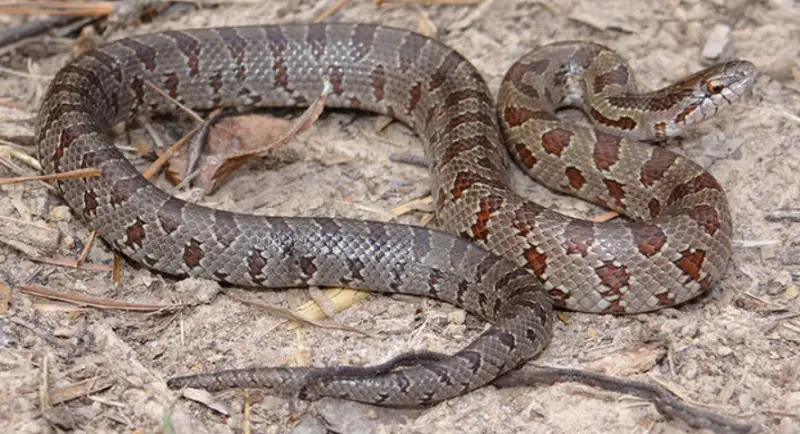
The Prairie Kingsnake is a medium-sized non-venomous snake, usually 30 to 42 inches long. It is light brown or gray with a pattern of darker blotches running down its back and smaller spots along its sides. Its smooth scales give it a shiny appearance, and its pattern may fade with age.
This species is secretive and primarily nocturnal, feeding on rodents, birds, and other reptiles. Like other kingsnakes, it is a constrictor and is immune to the venom of pit vipers. It rarely bites and typically flees when disturbed.
In Oklahoma, the Prairie Kingsnake can be found throughout the state, particularly in fields, meadows, and forest edges. It often hides under logs, rocks, or debris and may be encountered after rain.
Eastern Hognose Snake (Heterodon platirhinos)

The Eastern Hognose Snake is a stout, medium-sized snake known for its upturned snout and dramatic defensive displays. It typically ranges from 20 to 33 inches in length and comes in a wide variety of colors, from gray or brown to reddish or even black, with or without blotches.
It is completely non-venomous and feeds primarily on amphibians, especially toads. When threatened, it may flatten its neck like a cobra, hiss loudly, and play dead by flipping onto its back with its mouth open and tongue hanging out.
In Oklahoma, this species is widespread, especially in sandy or loose soils where it can burrow. It prefers open woodlands, fields, and dry uplands and is most active during the day.
Flat-headed Snake (Tantilla gracilis)
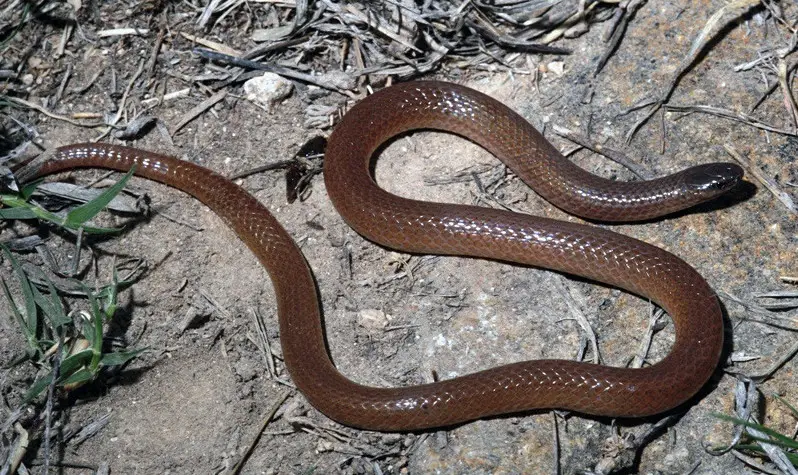
The Flat-headed Snake is one of the smallest snakes in Oklahoma, growing only 7 to 8 inches long. It has a slender body with a reddish-brown or tan color, a narrow head that is slightly darker, and a pink or orange underside. Its smooth scales and tiny size make it resemble a large worm.
This elusive, non-venomous snake spends most of its life underground or beneath leaf litter, logs, or rocks. It feeds on soft-bodied invertebrates like centipedes and insect larvae. It is very secretive and rarely seen.
In Oklahoma, the Flat-headed Snake occurs mainly in the eastern and southern parts of the state. It favors rocky hillsides, woodlands, and areas with loose, well-drained soil.
Graham’s Crayfish Snake (Regina grahami)
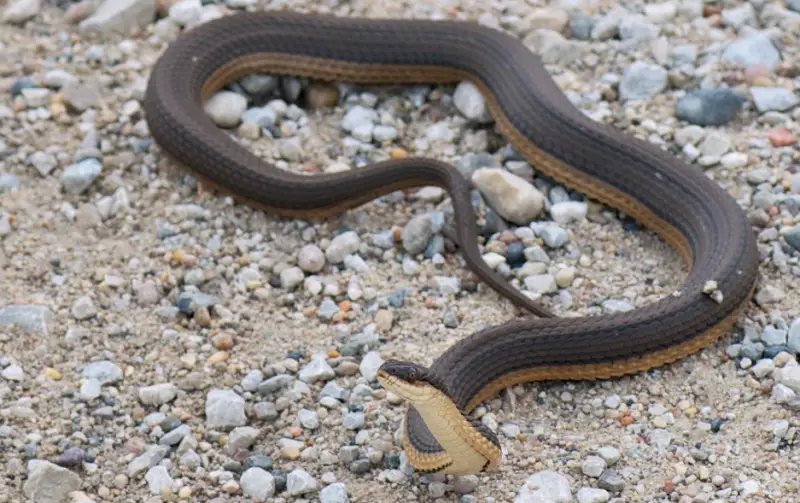
Graham’s Crayfish Snake is a medium-sized, semi-aquatic snake reaching 18 to 28 inches in length. It has a brown or olive body with faint stripes and a light-colored belly. Its scales are keeled, and it has a relatively slender build with a glossy appearance when wet.
This non-venomous species specializes in eating crayfish, especially freshly molted ones. It’s secretive and often found under rocks or debris near water. When handled, it may release a strong musk but rarely bites.
In Oklahoma, it is found near slow-moving streams, ponds, and wetlands, particularly in the central and eastern regions. It prefers muddy banks and vegetation-rich environments for concealment.
Rough Earthsnake (Virginia striatula)
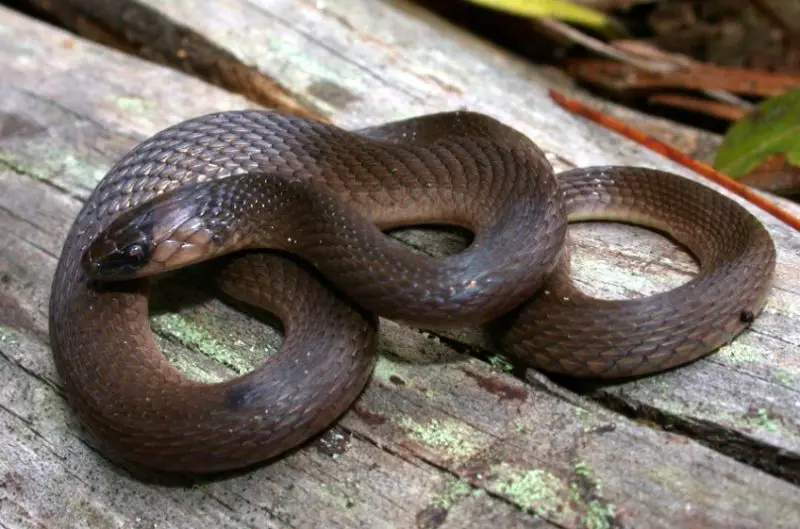
The Rough Earthsnake is a tiny, secretive species measuring only 7 to 10 inches long. It has a slender gray or brown body with a slightly pointed head and keeled scales. The underside is pale or whitish, and it lacks obvious markings.
Non-venomous and harmless, this snake feeds on soft-bodied invertebrates like earthworms and slugs. It is nocturnal and fossorial, spending most of its life under leaf litter, rocks, or soil. It almost never bites when handled.
In Oklahoma, it is more commonly found in the southeastern and eastern areas in moist woodland environments. It is often uncovered while gardening or flipping logs in shaded areas.
Ground Snake (Sonora semiannulata)
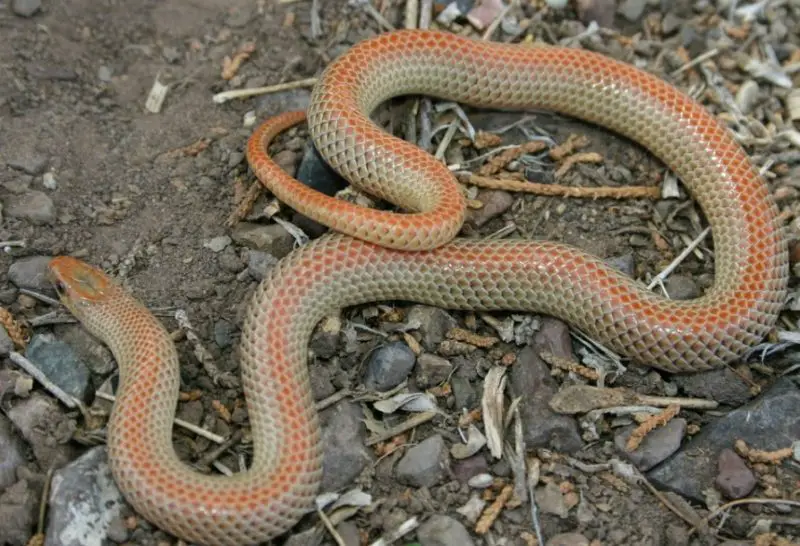
The Ground Snake is a small, highly variable species reaching about 8 to 12 inches in length. Its coloration ranges from orange or red with black crossbands to solid brown or gray, and it has smooth, shiny scales. Its variability can make it hard to identify.
This non-venomous snake is nocturnal and feeds on insects, spiders, and small invertebrates. It is secretive, spending much of its time under rocks or buried in sandy or loose soil. It is docile and rarely seen in the open.
In Oklahoma, it’s most commonly found in the western and southwestern regions, especially in arid or rocky habitats. It thrives in deserts, grasslands, and dry woodlands.
Common Watersnake (Nerodia sipedon)
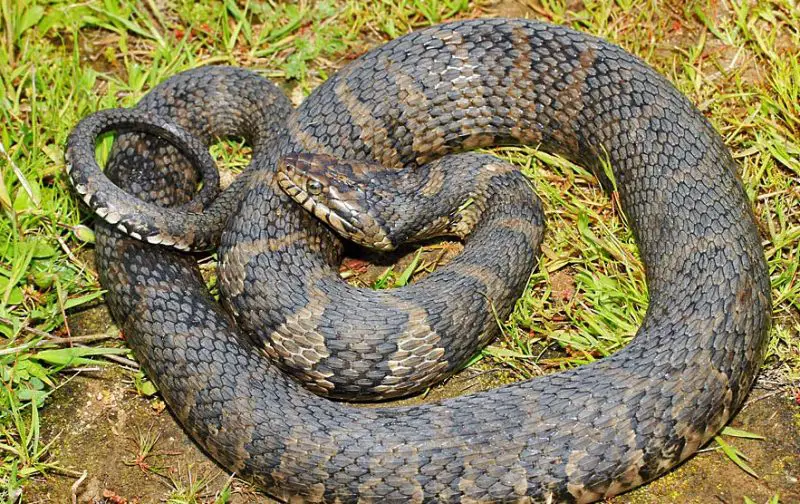
The Common Watersnake is a heavy-bodied, non-venomous snake that can grow up to 4 feet long. It has a brown or grayish body with dark crossbands or blotches and a lighter belly that may be speckled with red or brown. Its keeled scales give it a rough texture.
Although harmless, it is often mistaken for venomous cottonmouths due to its appearance and defensive behavior, which includes biting and releasing musk when handled. It feeds on fish and amphibians and is an excellent swimmer.
This species is widespread across Oklahoma and commonly found near lakes, streams, and marshes. It prefers basking on rocks or logs near the water’s edge.
Banded Watersnake (Nerodia fasciata)

The Banded Watersnake is a thick-bodied, non-venomous snake growing up to 3 to 4 feet in length. It has a pattern of broad, dark bands on a brown or reddish background, with a pale belly sometimes marked with half-moons. Its body is rough due to keeled scales.
This species is often confused with the cottonmouth but is harmless. It’s highly aquatic and feeds on frogs, fish, and other small aquatic animals. It may act aggressively when threatened but usually flees.
In Oklahoma, it occurs mostly in the southeastern corner of the state. It lives in swamps, ponds, and slow-moving streams, especially in heavily vegetated wetlands.
Great Plains Ratsnake (Pantherophis emoryi)

The Great Plains Ratsnake is a medium-sized non-venomous snake that grows between 24 and 50 inches in length. Its body is typically gray or light tan with dark brown blotches down its back and sides, and it often has a spear-shaped marking on its head. Its belly is checkered black and white, helping distinguish it from similar species.
It is a nocturnal and secretive constrictor, feeding primarily on rodents, birds, and lizards. This snake is generally calm and rarely bites, even when handled. It may vibrate its tail when threatened to mimic a rattlesnake.
In Oklahoma, it is commonly found in rocky hillsides, grasslands, and wooded areas, especially in the central and western parts of the state. It shelters under rocks, logs, or in old buildings and barns.
Western Milksnake (Lampropeltis gentilis)

The Western Milksnake is a brightly colored, non-venomous snake that grows up to 36 inches long. Its body is ringed with red, black, and white or yellow bands, which mimic the pattern of venomous coral snakes. It has smooth, glossy scales and a slender build.
This species is a constrictor that preys on rodents, reptiles, and amphibians. It is secretive and primarily nocturnal, often hiding under rocks or logs during the day. Although it may release musk when threatened, it rarely attempts to bite.
In Oklahoma, it occurs throughout much of the state in prairies, woodlands, and even suburban areas. It prefers dry, open habitats but can also be found near streams and grasslands.
Western Worm Snake (Carphophis vermis)
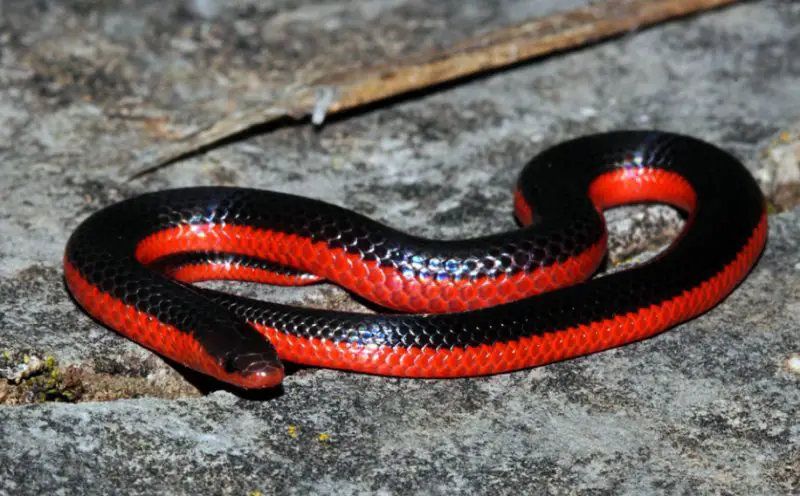
The Western Worm Snake is a small, fossorial species measuring about 7 to 12 inches in length. It has a glossy, dark brown or black back and a striking pink or reddish underside. Its head is small and pointed, ideal for burrowing.
Non-venomous and harmless, this snake feeds primarily on earthworms and other soft-bodied invertebrates. It lives underground and is rarely seen above ground except after rain or when unearthed. It may squirm vigorously or release musk when disturbed.
In Oklahoma, it is more common in the eastern and central regions, where it inhabits moist woodlands and hillsides. It prefers areas with loose, damp soil and abundant ground cover.
Checkered Garter Snake (Thamnophis marcianus)

The Checkered Garter Snake is a slender, medium-sized non-venomous snake that typically grows 18 to 28 inches long. It is easily recognized by the black checkerboard pattern on its greenish or yellowish back, along with light stripes running along the body.
This snake is active during the day and feeds on a wide variety of prey, including frogs, fish, insects, and earthworms. It is quick to flee when approached but may flatten its body or release a foul-smelling musk if captured.
In Oklahoma, it is found primarily in the southwestern regions in habitats such as grasslands, near streams, and along irrigation ditches. It adapts well to semi-arid environments and prefers areas with both cover and access to water.
Texas Blind Snake (Rena dulcis)

The Texas Blind Snake is a tiny, worm-like, non-venomous snake averaging 6 to 11 inches in length. It has a shiny, pink to purplish body with smooth scales and a blunt head and tail. Its eyes are vestigial and covered by scales, making it appear eyeless.
It feeds mainly on ants, termites, and their larvae, using its small mouth to probe into colonies. It lives underground and is rarely seen, except when heavy rains bring it to the surface. It poses no threat and does not bite.
In Oklahoma, it is found mostly in the southern and western parts of the state. It prefers loose, sandy soils in arid or semi-arid environments, such as grasslands, desert scrub, and occasionally suburban yards.
Glossy Snake (Arizona elegans)

The Glossy Snake is a smooth-scaled, non-venomous species that grows between 30 and 45 inches long. It has a tan or light brown body covered with darker brown blotches, giving it a faded, camouflaged appearance. The head is slightly wider than the neck, and the eyes have round pupils.
Primarily nocturnal, this snake preys on small rodents, lizards, and occasionally birds. It uses constriction to subdue its prey and is generally calm in nature. When disturbed, it may vibrate its tail in dry leaves to mimic a rattlesnake.
In Oklahoma, it occurs mostly in the western and southwestern regions. It favors sandy or rocky soils in grasslands, shrublands, and desert-like habitats, often sheltering under rocks or in abandoned burrows during the day.
Plains Hognose Snake (Heterodon nasicus)
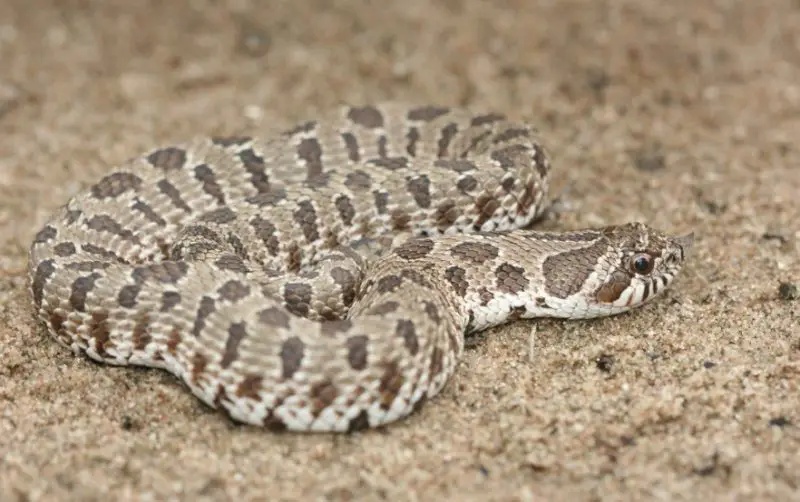
The Plains Hognose Snake is a stout, non-venomous snake recognized by its upturned, shovel-like snout. It typically measures 15 to 25 inches long and has a gray or tan body with darker blotches along its back and sides. Its snout is adapted for burrowing in loose soil.
This species is famous for its dramatic defensive behaviors, including flattening its neck, hissing, and even playing dead. It feeds on amphibians, reptiles, and small mammals, and is immune to the toxins of toads, which form a large part of its diet.
In Oklahoma, it is widespread in open grasslands and sandy prairies, especially in the western and central parts of the state. It prefers dry habitats with loose soils for digging and spends much of its time underground.
Chihuahuan Nightsnake (Hypsiglena jani)
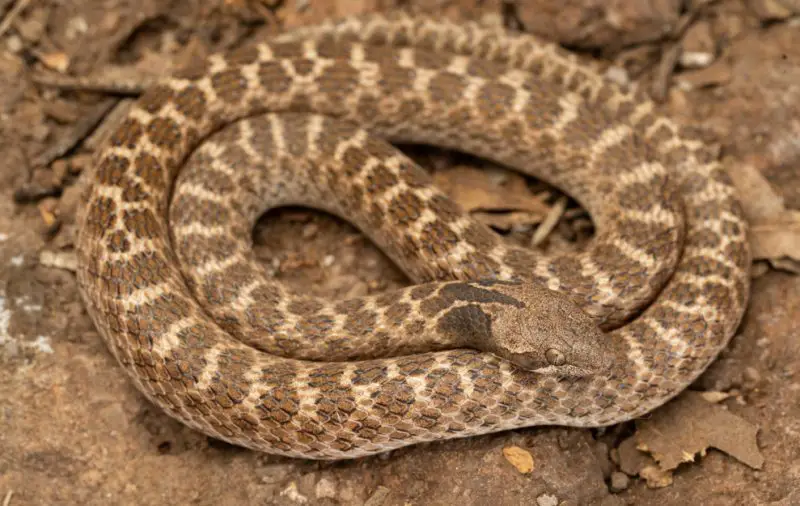
The Chihuahuan Nightsnake is a slender, mildly venomous but harmless-to-humans species that reaches about 12 to 18 inches in length. It has a light tan or gray body with dark brown blotches and a dark stripe extending behind each eye. Its vertical pupils are an identifying feature.
This snake is nocturnal and secretive, hiding under rocks or debris during the day. It feeds primarily on small lizards and amphibians, using mild venom delivered through rear fangs to subdue its prey. It rarely bites and is very shy.
In Oklahoma, it is found mostly in the southwestern corner of the state, preferring arid and rocky habitats. It is uncommon and typically seen only at night or after rain.
Plains Black-headed Snake (Tantilla nigriceps)
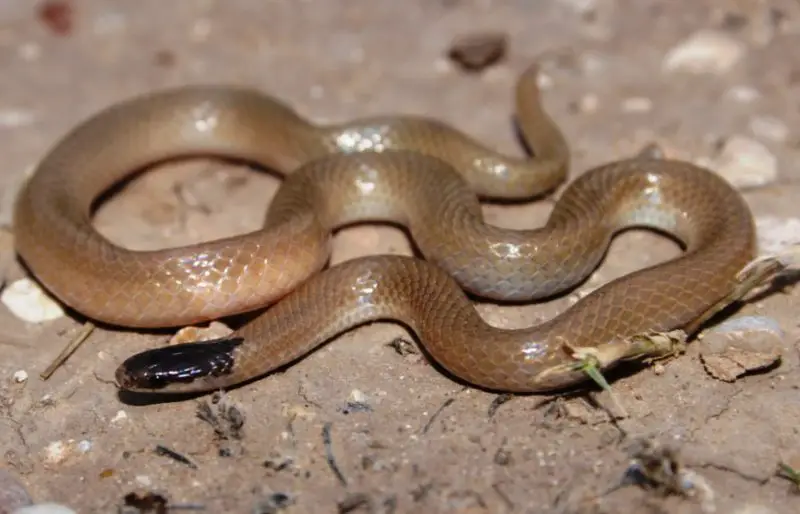
The Plains Black-headed Snake is a small, slender non-venomous species that grows up to 13 inches long. It is brown or gray with a distinctive black or dark brown head and a pink or reddish belly. The coloration is subtle, making it difficult to spot in the wild.
It is fossorial and rarely seen above ground, feeding mostly on insects, spiders, and centipedes. It is harmless and non-aggressive, often curling into a ball when disturbed. Its tiny size and secretive nature make it one of the least encountered snakes in Oklahoma.
This snake is found across central and western Oklahoma, where it inhabits loose, sandy soils in grasslands, woodlands, and rocky outcrops. It prefers areas with good ground cover and moisture.
Smooth Earthsnake (Virginia valeriae)

The Smooth Earthsnake is a small, secretive non-venomous species that measures between 7 and 10 inches long. It has a plain brown or grayish body with smooth scales and a pale belly. Unlike its rough-scaled cousin, its scales give it a sleek appearance.
This snake spends most of its time underground or hidden beneath leaf litter, logs, and rocks. It feeds mainly on soft-bodied invertebrates like earthworms and slugs. It is very gentle and seldom tries to bite when handled.
In Oklahoma, it is found mostly in the eastern parts of the state, especially in moist forests and wooded areas. It prefers habitats with rich leaf litter and loose soil for burrowing.
Red-bellied Snake (Storeria occipitomaculata)
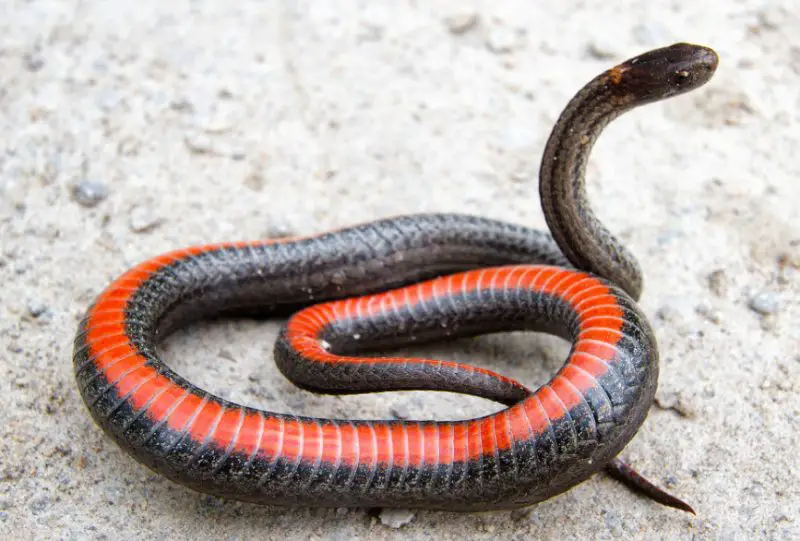
The Red-bellied Snake is a small, non-venomous species known for its reddish or orange belly, contrasting with a gray to dark brown back. It grows up to 10 inches long and may have a faint stripe running down its spine. A pair of light-colored spots often appears behind the head.
This snake is secretive and fossorial, commonly found under rocks, logs, and leaf litter. It feeds on slugs, earthworms, and soft-bodied insects. It is harmless to humans and rarely seen due to its reclusive habits.
In Oklahoma, the Red-bellied Snake inhabits moist woodlands and forest edges, particularly in the eastern and southeastern regions. It prefers shaded, damp environments with plenty of organic cover.
Plains Garter Snake (Thamnophis radix)
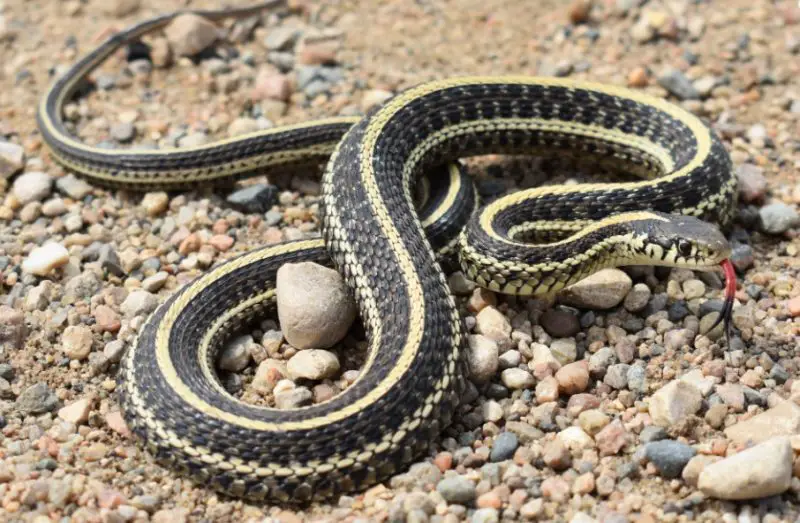
The Plains Garter Snake is a medium-sized, non-venomous species with a yellow or orange stripe running down its back and additional lateral stripes. Its background color is typically olive, brown, or black. Adults typically grow between 16 and 28 inches in length.
This adaptable snake feeds on amphibians, fish, worms, and small rodents. It is active during the day and often found near water sources. Though non-venomous, it may emit a musky odor when threatened.
In Oklahoma, the Plains Garter Snake is found mainly in the northern and western parts of the state. It thrives in prairies, meadows, and marshy habitats, often near streams and ponds.
Long-nosed Snake (Rhinocheilus lecontei)
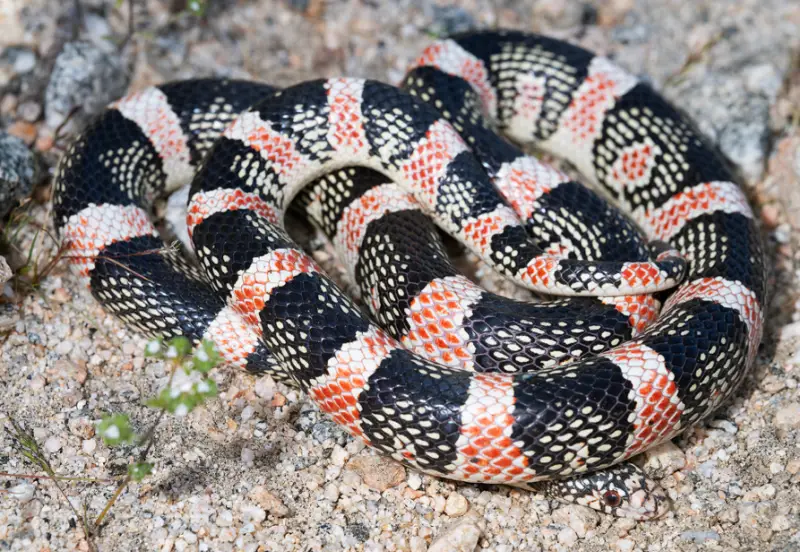
The Long-nosed Snake is a slender, non-venomous species with a distinctive black and red banded pattern on a creamy white background. It can grow up to 30 inches long and is named for its slightly upturned snout, adapted for burrowing.
Nocturnal and shy, it spends much of its time underground. It feeds on amphibians, lizards, and small snakes, sometimes using mild constriction. When disturbed, it may release a foul-smelling musk or play dead.
In Oklahoma, this snake occurs in the southwestern regions, especially in arid grasslands and desert-like habitats with sandy or rocky soils.
Mudsnake (Farancia abacura)
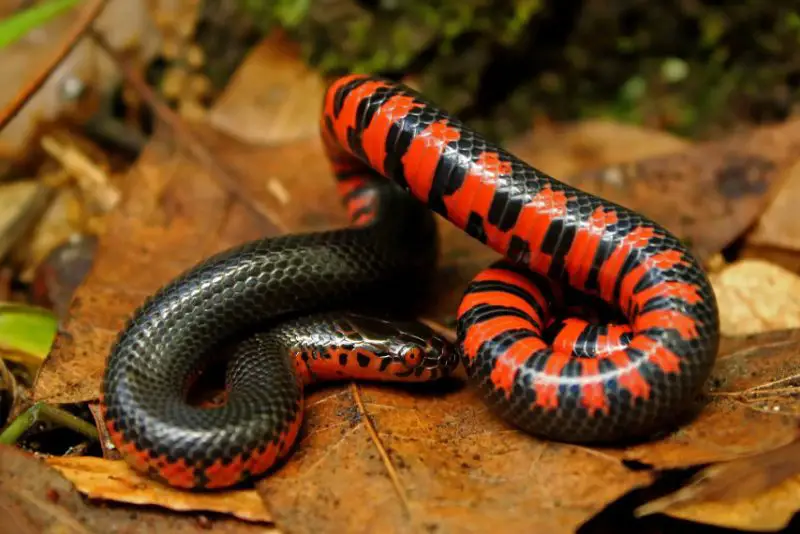
The Mudsnake is a large, glossy, non-venomous aquatic snake reaching up to 60 inches in length. Its upper body is shiny black while the belly features alternating red and black bars that may extend up the sides. The tail ends in a harmless, sharply pointed tip.
It is semi-aquatic and preys mainly on amphibians like salamanders and sirens. This snake is non-aggressive and rarely bites, relying on its striking appearance and tail display as a defense mechanism.
In Oklahoma, the Mudsnake is primarily found in the southeastern corner of the state, in slow-moving streams, swamps, and wetlands with abundant vegetation.
Scarletsnake (Cemophora coccinea)

The Scarletsnake is a small, non-venomous species known for its bright red blotches bordered by black on a light gray or cream background. It typically grows up to 20 inches in length. Unlike the venomous coral snake, its red bands do not touch yellow.
This fossorial snake feeds on reptile eggs, small rodents, and amphibians. It is rarely seen above ground and spends much of its life hidden under leaf litter or logs. It is harmless and not aggressive.
In Oklahoma, the Scarletsnake is considered rare, with scattered populations in the southeastern forests. It prefers sandy, wooded areas with loose soils for burrowing.
Black-necked Garter Snake (Thamnophis cyrtopsis)

The Black-necked Garter Snake is a slender, non-venomous species notable for the two large black blotches on either side of its neck. It typically has a yellow to orange dorsal stripe running the length of its dark green or brown body. Adults grow up to 30 inches long.
This diurnal snake is semi-aquatic and often found near water. It preys on amphibians, small fish, and invertebrates. While harmless to humans, it may release a foul-smelling musk if handled.
In Oklahoma, it is primarily found in the far western and southwestern parts of the state, particularly in riparian zones and near streams.
Glossy Swampsnake (Liodytes rigida)
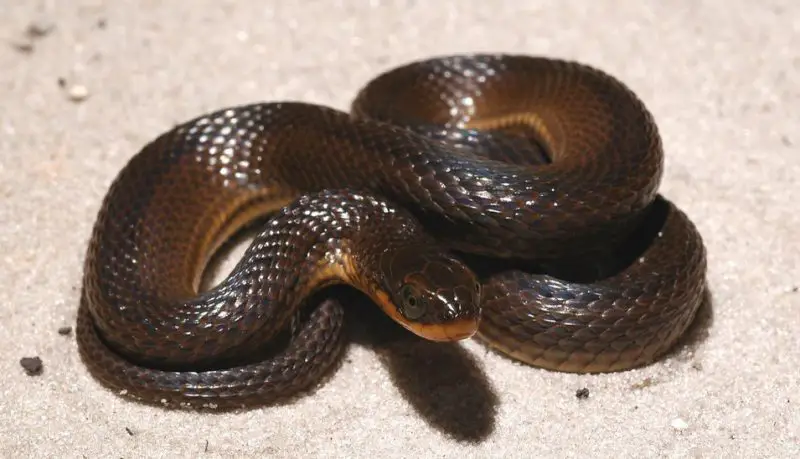
The Glossy Swampsnake is a small, secretive, non-venomous snake with a smooth, glossy appearance. Its body is olive to dark brown, and it lacks prominent markings, making it easily mistaken for other watersnakes. It reaches lengths of 15 to 24 inches.
This species is highly aquatic and rarely seen on land. It feeds almost exclusively on crayfish, using its rear-facing teeth to grip slippery prey. It is docile and rarely bites.
In Oklahoma, the Glossy Swampsnake is found in southeastern regions, preferring swamps, marshes, and sluggish streams with dense vegetation and muddy bottoms.
Lined Snake (Tropidoclonion lineatum)

The Lined Snake is a small, non-venomous snake with four distinct pale stripes running lengthwise along its gray or brown body. Its belly features two rows of dark half-moon spots. Adults grow only 8 to 15 inches in length.
This fossorial snake is often found beneath rocks, logs, or leaf litter. It feeds on earthworms and small invertebrates. Though rarely seen, it is harmless and will not bite when encountered.
In Oklahoma, the Lined Snake is found mainly in the central and northern parts of the state, favoring open grassy habitats with moist soils.


